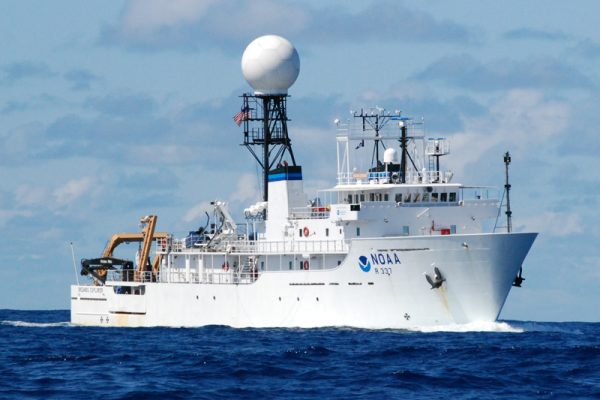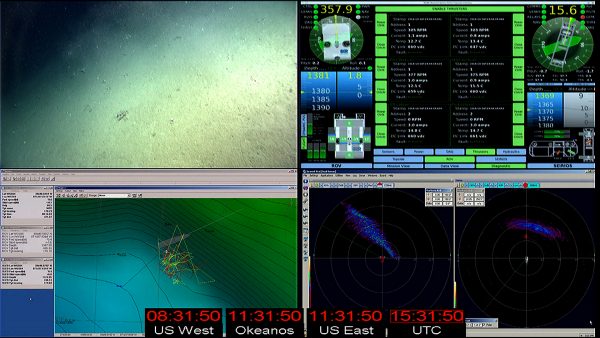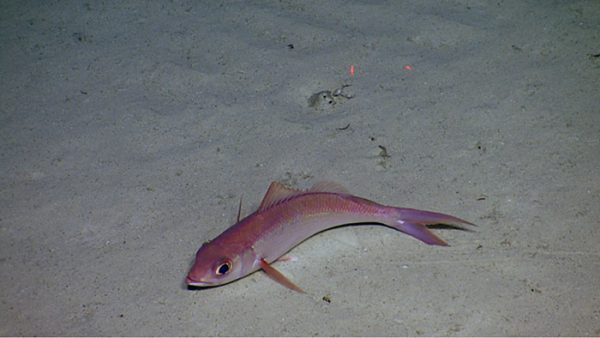
Photo courtesy of NOAA
Imagine looking down on where you live from 20,000 feet above. Now imagine 95 percent of what’s below has never been seen. That’s what it’s like exploring the deep sea—the planet’s largest and most unknown habitat.
The deep-sea environment is ominous and harsh. There is no light and the pressure at some of the deepest parts of the ocean is equivalent to the weight of an elephant balanced on a postage stamp. The temperature at these icy depths drops below 32 degrees Fahrenheit. Fish had to evolve unique and sometimes strange adaptations to live in these conditions, giving them an unearthly appearance.
This otherworldly habitat is the focus of Okeanos Explorer, the only federally funded U.S. ship assigned by the National Oceanic and Atmospheric Administration to systematically explore the ocean’s biodiversity and geography.
Undersea footage streams live from the Okeanos using satellite technology, which allows scientists and citizens to follow the expedition.

Florida Museum photo by Randy Singer
“We’re going to these places that nobody’s gone before, but we’re also taking anybody with us who wants to go,” said Randy Singer, an ichthyology doctoral student at the Florida Museum of Natural History. “That’s the crazy part. There are places that have been more explored than the deep sea, but the public still hasn’t really seen them. With Okeanos Explorer, thousands of people are coming together to see unexplored parts of the ocean for the first time.”
Singer joined Okeanos as a shore-based scientist in 2013 when the expedition went to the mid-Atlantic. Since then he has participated in four expeditions to places like Puerto Rico and Hawaii, without leaving his desk at the Florida Museum.
The ship’s telepresence technology, which uses satellites and the Internet to transmit footage in real-time from remotely operated deep-sea vehicles to a shore-based hub at the University of Rhode Island, is then broadcast to onshore scientists and the public.
A large team of onshore biologists of varying disciplines and geologists stream the real-time feed online, contribute to discussions and study new discoveries. Simultaneously, the public may watch and listen as scientists explore the ocean.
Singer is currently working on a project with other onshore ichthyologists to identify fish spotted during Okeanos Explorer’s 2014 expedition to waters off Puerto Rico. The mission was aimed at tracking the locality of the Queen Snapper, a sought-after species by commercial fisheries in the Caribbean. Classrooms and research labs in Puerto Rico and around the globe tuned in as scientists searched for the Queen Snapper among many other deep-sea animals and geologic features.
“Thousands of people watched us find one of the largest sponges ever photographed. It was huge. When I say huge, I mean it was the size of a strip mall,” Singer said.
During the Puerto Rico expedition Singer noticed a strange red fish that he couldn’t initially identify. After some investigation, he realized it belonged to a group of smooth dory fish and may be a new species. A paper describing the new species is currently in the works and expected to be published next year.

“With every fish that we see, all of the fish people collaborate to identify it, study new range extensions and interesting behaviors, or even determine if the fish has ever been seen,” Singer said.
Typically a biologist and a geologist on the boat lead each expedition and coordinate the group of up to 30 shore-based scientists. The group collectively decides what to focus on and where to sample in pre-expedition meetings as well as in real-time via a group satellite conference call. The lead scientists decide what species to capture and the skilled pilots maneuver a mechanical arm attached to an underwater remote operating vehicle to collect specimens.
“It’s just like the claw game where you go after the stuffed animal, except there is a two-second delay and the whole time the pilot steering the ship is trying to make sure the ROV doesn’t move from that spot. But they still nail it every time,” Singer said.
So what is it about the deep sea that draws scientists out to sea and attracts thousands of Okeanos viewers to their computer screens? Singer said it’s mostly curiosity. But there are more practical reasons for the project’s exploration. Although it seems disconnected, the deep sea is not safe from environmental threats like ocean acidification and pollution.
When animals at the surface fall victim to environmental threats, it exponentially reduces the amount of energy that reaches the deep sea, Singer said. Fish at the surface provide what scientists call ‘marine snow,’ which is discarded flesh, scales and other parts left when an animal is eaten or dies of natural causes that drift down to the deeper levels, Singer said. For example, when whales die, their carcasses sink to the bottom and can feed an entire community of deep-sea fish for months or even years.
“The reality is when you damage things at the surface, you’re definitely indirectly affecting the fish at deeper levels,” Singer said.
But to protect the deep sea, first we have to find out what’s out there. If we somehow drained the planet of all its water, Singer said the continents would look like tiny mesas, with huge canyons and enormous mountains down below us.
“Mt. Everest is a molehill compared to what’s in the ocean,” Singer said. “But we only know about 5 percent of the species that live there and even less about its geography.”
Since we currently have no way to monitor the deep sea, Singer said overfishing of species like Orange Roughy, a deep sea fish that is over harvested commercially in the Pacific, is dangerous because we don’t know how many exist. “We don’t know very much about the deep sea because it’s just so remote,” Singer said. “Sampling it with nets is like flying over New York City in a helicopter with a bucket hanging off of it and trying to catch cockroaches.”
Hindrances in investigating unexplored areas of the ocean during netting expeditions led NOAA to commission the Okeanos Explorer in 2008. Netting expeditions require grueling months at sea and spots on the boat are limited, which also restricts the variety of scientific expertise available on-site during missions.
Before signing up with Okeanos, Singer experienced an expedition at sea firsthand. He spent two months in 2009 with the NOAA Mid-Atlantic Ridge Ecosystem Project collecting deep-sea specimens as far as 18,000 feet below the surface.
“Life on an ocean expedition is comparable to living on a slow-motion roller coaster for weeks, Singer said. “Going to sea isn’t for everyone, since expeditions often go very long periods of time without returning to shore. When you start out, you have fresh food and by the end you’re literally eating Helper–not Hamburger Helper, just Helper. By the last week, there’s no fresh fruit and you start to get cabin fever.”
For scientists who aim to explore the deep-sea—a place humans cannot visit due to the crushing pressure—technology has become the key to unlocking its secrets.
“The age-old selling point for deep sea research is that we know more about the surface of the moon than we do about the deep ocean. I mean, talk about needing to know more about our planet’s biodiversity. That’s the first place we can look,” Singer said.
Learn more about the Ichthyology Collection at the Florida Museum.